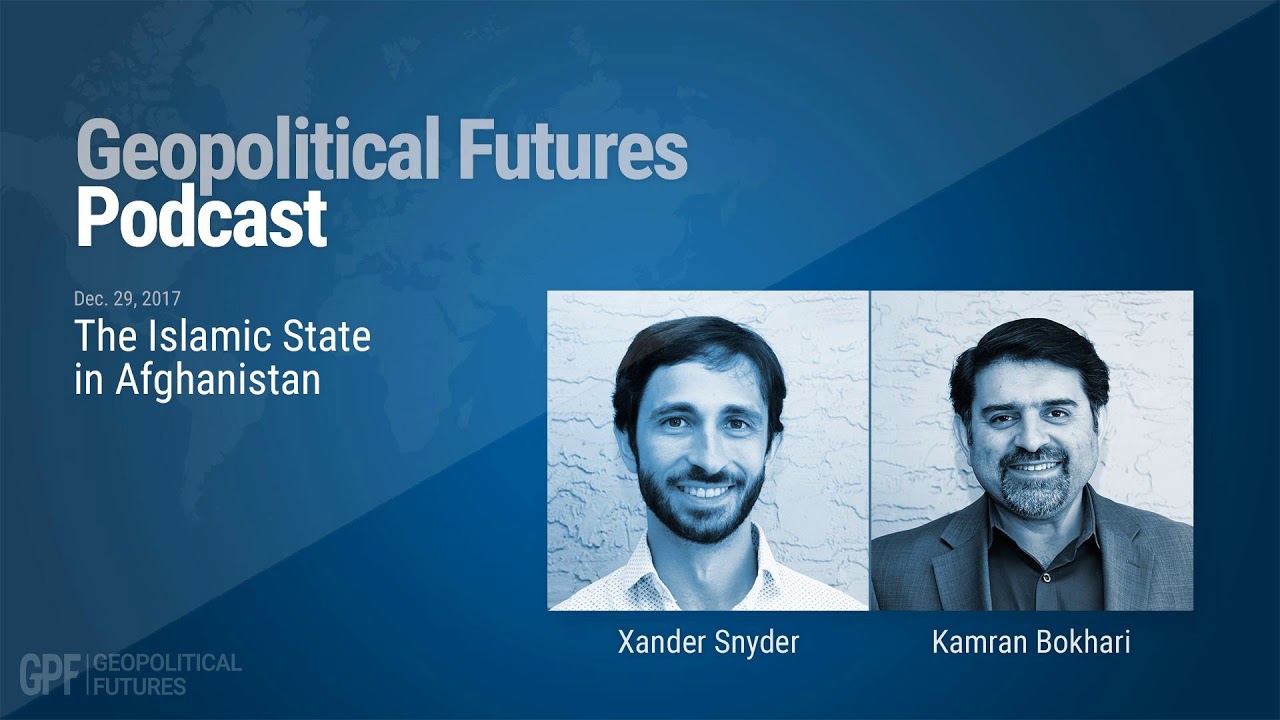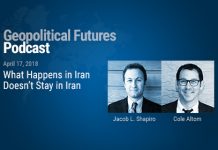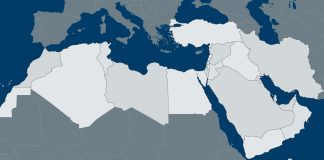Xander Snyder: Hi and welcome to the Geopolitical Futures podcast. I’m Xander Snyder and I’m joined today by Kamran Bokhari. And today we’re going to be talking to you about what comes next and sort of the next stage of the Middle Eastern conflict now that ISIS has not been defeated necessarily in Syria but degraded. They’re seeking refuge and bases elsewhere, and one of those locations that ISIS is moving to is Afghanistan. So Kamran, let’s just start off simple, why is ISIS focusing more now on Afghanistan?
Kamran Bokhari: So Xander, the modus operandi of ISIS and before it al-Qaeda and in general jihadist groups, is to take advantage of anarchic conditions. They lack the capability to operate in a state that’s strong where the economy is as well, at most they can do terrorism there, but they can’t put down roots. And so the lesson from their point of view is to able and go and operate and take advantage of an area where there are conflicts.
And Afghanistan is, we’re coming close to the 40th anniversary which will be in 2019, of the Soviet intervention in Afghanistan that kicked off the war there. So two generations of warfare has produced social, political and economic conditions on the ground that are conducive to ISIS’s ambitions. And it’s a jihadist rich environment to begin with, so it can go and poke into the existing infrastructure, peel off people, which it has already done and build from there.
And now we see in light of the recent attack on the Shia center in the capital of Kabul and the fact there have been at least half a dozen claimed ISIS attacks in the Afghan capital in recent weeks and months, that suggests that those roots are now firmly in place and ISIS is able to, its machine is able to operate.
XS: Now historically or at least certainly before the 2001 invasion by the U.S., the Taliban was more or less sort of like the governing, I mean they were basically in control of the country and now they are gaining some more control over the country over the last couple years. And you know just because they have the upper hand in the battle right now, they’re not really particularly willing or desiring to negotiate with the government which is something that the United States obviously wants so that they can draw down forces.
But the Taliban is, and this is a distinction that you’ve drawn before, is a nationalist jihadist group. They have designs that focus on objectives within Afghanistan and this is different for the Islamic State and for al-Qaeda. So now that we’re seeing the Islamic State, a trans-national Islamic group that has designs outside of strictly Afghanistan moving into Afghanistan, what implications does that have not just for the country itself but for South Asia generally?
KB: So what has happened with the arrival of ISIS in the region in Afghanistan in particular, is that the Taliban are facing a challenge. And there’s a competition over who has the leadership over the ideology of jihadism and the fact that the Taliban have been facing you know stress and strain in terms of their movement. They’ve lost two leaders in a short span of about four years, two central leaders including the founder Mullah Mohammed Omar. And there’s been factionalization, there’s been pre-existing fragmentation of the Taliban movement.
The Taliban for many, many years now ever since the fall of their government that you noted, does not exist as a monolithic entity. It’s a much more diffuse movement consisting elements that are either ideologically motivated or motivated by other interests. At one point I was interviewing a former Taliban official and he told me, this was in 2011, that as much as about 40% of the Taliban movement consists of groups and elements that are opportunists. They may be warlords in their area, they may be tribal leaders, they are even organized criminal syndicates and crime bosses that have joined the movement to further interests or protect their interests from the Taliban. So in that climate, ISIS sees a lot of room to maneuver.
So the Taliban, their situation of fragmentation and the general chaos within Afghanistan, so I’ve already noted how the Taliban, the jihadist landscape is extremely fractious. Conversely, the anti-Taliban are actually far more fractious than the Taliban. And this is an environment that ISIS can come in and exploit.
ISIS did not bring fighters from Iraq or Syria, perhaps an advisor or someone or people, a small group of people who had experience with ISIS in Iraq and Syria came in as advisors or leaders and they mobilized people who were disgruntled with the Taliban or with the general state of affairs. And they also synced up with elements from Central Asia that are based in Afghanistan and of course across the border in Pakistan. Ever since the Pakistani Army went after jihadist rebels in 2009 and has been fighting a massive insurgency for many years. There’s been quite a bit of fragmentation in the landscape there.
So ISIS comes in and says all these elements are useful to us and they’re trying to mobilize different parts of the broader jihadist tendency within Southwest Asia towards them in order to be able to, if you will, adopt the jihadist movement in Afghanistan and assume its leadership.
XS: Now I know we’re focusing more on the Islamic State in Afghanistan but I’m curious because you bring up this issue of the variety that exists within the Taliban, it not simply being a monolithic identity, one of or at least one of the many important distinctions is between the Afghan Taliban and the Pakistani Taliban. What are the differences between these two organizations and how does Pakistan use that differentiation for its owns aims in South Asia?
KB: That’s an excellent question. And I do want to point out that this is a fluid space, very fluidic. It’s ideology, there’s not much difference in ideology, perhaps the only difference would be the scope in which you want to operate. You already mentioned how the Afghan Taliban, the core of the movement, is very nationalistic, doesn’t have any ambitions beyond the border of Afghanistan. But having said that, their basic core ideas of you know what they envision as a polity, is not that different from ISIS, al-Qaeda, the Pakistani Taliban and other groups. So having said that, this is a challenge for the Pakistanis.
Now at one point, the Pakistanis essentially nurtured the Afghan Taliban when they were emerging in the mid-‘90s and became their biggest patron. The Afghan Taliban have remained a proxy force of the Pakistani but in recent years and increasingly so since 9/11 and the aftermath, the Pakistanis have lost control over this landscape. New actors have emerged, there’s been a Talibanization of Pakistan. And the Pakistani Taliban, while they maintain ties with the Afghan Taliban, have very different goals. They seek to overthrow the Pakistani state. While the Afghan Taliban see the Pakistani state as an ally, as a patron, as a benefactor that can help them achieve their goals in Afghanistan.
And so the challenge increasingly so for the Pakistanis, how do they distinguish between these two actors? Because the geographic battlespace is the same. And the illogical space and the operational space is very fluid, so it’s becoming increasingly a problem for the Pakistanis to be able to back the Afghan Taliban, not that they still don’t do it. They do but it’s becoming increasingly difficult because you have to distinguish between friend and foe and if you are operating in say you know a single district within the tribal belt, for example north of Waziristan where the Pakistanis conducted a large-scale operation beginning in June of 2014.
And so at that point in time, it became very clear that the Pakistanis couldn’t simply use that space to nurture back the Afghan Taliban who were fighting NATO, the U.S. and Afghan forces on the other side of the border, because that same area was occupied by other factions who wanted to wage war against the Pakistanis. So this is an increasingly complex situation that the Pakistanis are having a hard time distinguishing, making that so-called distinction between the “good Taliban” and “bad Taliban.”
XS: Wow so it gets complicated as you move further east. And then of course, you have more complexity by moving north of Afghanistan because there you have Central Asia. And Central Asia is a region that we’ve identified as being in the intersection of sort of the spheres of interest of a number of much more powerful states and areas. So you have Russia to the north, you have China to east of Central Asia and sort of in the middle is this intersection of Kazakhstan, Kyrgyzstan, Uzbekistan, Tajikistan, Turkmenistan.
Now as more trans-national jihadists like Islamic State take up a position in Afghanistan, what threat does that pose in Tajikistan, which sits right to the north of Afghanistan, then the rest of Central Asia? And how does that potentially threaten the security of some of these bigger states that sit on the periphery of Central Asia?
KB: So it is a major concern, which is why we see leaders from all of these countries you know frequently mention the threat of they call it religious extremism, Islamism, jihadism, terrorism. There are different you know ways in which they express or identify the threat but the threat is the same. It is from jihadist elements whether they are from ISIS, whether they are from you know local groups like the Islamic Movement of Uzbekistan.
And so the key issue is and the key threat is spillover from Afghanistan. So recently, I think it was the Russian President Vladimir Putin, I think it was a few days ago when he made the statement that, and I’m paraphrasing here, a long-term U.S. military presence in Afghanistan is actually in the interest of Russia because what it does is it ties down or at least contains, keeps a check on the jihadist lava that’s bubbling in Afghanistan and prevents a spillover or at least limits a spillover.
Now having said that, there’s definitely this spillover effect. But there’s also something that’s indigenous to countries like Kyrgyzstan, Kazakhstan and Uzbekistan in particular, is that they have homegrown religious tendencies that are anywhere from you know just good old fashioned, ultra-conservative, medieval understanding of religion to a well established, political ideology of Islamism and violent extremism. So that’s bubbling from within.
And the question is that, is ISIS going to be able, because ISIS right now seems to be the organization that is capable of, or at least has shown and demonstrated the capability to go in, take advantage of local grievances and circumstances and expand its footprint. We just saw that in the Philippines. We’re seeing that in Bangladesh and we’re also seeing that in Indonesia. So this is the opening of a new area and that is the fear that right now there’s no organized group, these are sentiments, these are social movements, not necessarily with much organization. But what if ISIS was able to access these places and provide that kind of organization, then the Central Asian republics have a much, much bigger problem at home than just sort of latent, religious extremism.
XS: And in what circumstance would that occur? Because a lot of these Central Asian countries have been ruled essentially by, call them authoritarians or strongmen for the last several decades. Uzbekistan recently had a power transition and seems to be handling that ok. But what opportunities would or what events could provide those opportunities for the trans-national jihadists to expand and secure a greater foothold within the Central Asian states?
KB: So the example of Uzbekistan is very good here, because the new president, Shavkat Mirziyoyev, he is trying to strike a balance between not completely doing away with the autocratic nature of the state. But at least allow for some relaxation where you can let the public blow off steam and manage the pressure that’s been building ever since the country sought independence from a crumbling Soviet Union in 1991. And that’s tricky.
So you allow, you don’t want to suppress religious extremism for fear of making it bigger, but you allow it then, how are you sure that it is not going to turn against you, the freedom that you’re giving? So we see this contradictory behavior taking place inside the country. We recently were discussing about how the Finance Ministry and the security establishment are being rejiggered, reshuffled, purging of old people, bringing in new, setting up new protocols where people are not you know living in a police state, you know dealing and accounting for corruption and having more transparency, in the hope that all these things will help manage whatever social unrest is bubbling and manifests itself in the form of religious extremism.
And that’s a huge challenge, obviously it’s also the transition where the current President is trying to establish and consolidate his rule. He has to get rid of elements that can pose a challenge to him, such as the former Finance Minister and Deputy Prime Minister Rustam Azimov and then the other Rustam, who is the head of the Intelligence Service, Rustam Inoyatov. And these two people were powerful individuals, power centers who worked with the current President’s predecessor for many, many years. So there’s that aspect as well that is complicating this.
And ISIS is looking at this and saying how do we actually go ahead and exploit these situations? So for example, right now most of the ISIS, most of what is identified as ISIS in Central Asia, is either latent religious extremism at a social level, not necessarily manifesting politically yet or it’s essentially Central Asian citizens, Kazak citizens, Tajik citizens, Turkmen citizens, Uzbek citizens, going to foreign battle zones such as Syria and Iraq and becoming veterans there.
In fact to the extent that the reports can be relied upon, given that ISIS is such an insular entity that we really don’t know fully what its hierarchy looks like, but the current military chief is reportedly a former commander of Tajikistan’s Special Forces. He took over from his Chechen predecessor. So the fear is that you have these social problems and then you have these battle harden individuals if they found their way back or if they can communicate with their people, their allies on the ground than they can really stir up problems.
XS: So the issue of religious extremism as they put it, is obviously one of the challenges that Central Asia is facing now. Central Asia actually comprises a fairly important place in our model because it is an intersection of such other greater interests. And we see the region facing quite a bit of challenges above and beyond just strictly jihadism. So what other challenges is Central Asia facing in the coming years Kamran and how is that play into our model and why we expect to be sort of a difficult place to maintain stability in the next couple of years?
KB: So in many ways Central Asia, what is happening today, is a continuation, is the latest chapter in the process that essentially was triggered by the collapse of the Soviet Union. These countries gained independence as sovereign entities but Russia has a great deal of influence, continues to of course to varying degrees in each of the five countries. There is also a pushback from some of these countries especially now that Russian influence, you know Russia has internal challenges with regards to its political economy and it is also going through, it’s a pending transition, Putin has been at the helm for you know almost twenty years.
And so given all these conditions, these countries are moving into what would be called undiscovered country. There’s also leadership transition, you know its already taken place in Kyrgyzstan, a few times it’s been violent considering the 2007, 2010 uprisings. It hasn’t been violent but it’s really fragile and volatile in Uzbekistan. We still have you know former communist party bosses ruling Kazakhstan as in the case of Nursultan Nazarbayev, and the Turkmen leader as well as the Tajikistan leader.
So there is transition, there is the weakening of Russia, there is an increasing Chinese footprint. The world is changing, these countries are opening up in terms of you know the effect of what we would call globalization where they’re becoming connected with the outside world. That has social and political and economic consequences especially in the age of social media.
And so these are sort of the core challenges in terms of how do these regimes maintain stability, maintain order and continue to provide for a viable, political economy especially when some of these countries rely heavily on energy prices. Kazakhstan being a big one, Turkmenistan is another one. Some of these countries are in sort of slow motion fragmentation so for example Turkmenistan is fragmenting or destabilizing at a slower pace because it has a very small population. But it’s also heavily reliant on natural gas exports. Tajikistan has an efficient security force but it is heavily reliant on Russian assistance now to the extent that Russia can play a role in these areas.
So on the one hand they need Russia and they don’t want a sudden vacuum where Russia is unable to, I mean they already dealt with it in the form of the collapse of the Soviet Union and they became independent. And now we’re in the second phase where ok you’re independent, how do you operate at a time when Russian influence is weakening and you have your own, you know twenty-five years is a long time to develop your own dynamics. There’s a certain local or regional logic that is emerging that interacts with Russian influence, Chinese influence. And of course, the trans-national jihadist ideology is also playing a role. So I think that is a way of understanding what is happening to Central Asia.
XS: So for our readers out there, if this is a subject that interests you, the state of Central Asia and how despite maybe not getting the same degree of attention that other regions of the world often do, is actually quite an important one and one that we focus on. You can read more about that in our 2018 forecast, which we just published in the last week or so.
So just as a recap what we talked about on this episode was how developments in Syria, in the Middle East and the deterioration of the Islamic State’s position there is impacting the influx of trans-national jihadists to Afghanistan and that has broader implications for Central Asia, the region that sits just to the north of Afghanistan. And once you start getting into that region that has overlapping interests from China and Russia, all of the sudden one development in the Middle East, starts to impact a far greater area. And that’s really what we try to focus on is the interconnection of all of these different developments. So Kamran, thanks for taking the time and sharing all this information with us, it’s always a learning experience.
KB: Likewise, thank you.







 The Geopolitics of the American President
The Geopolitics of the American President